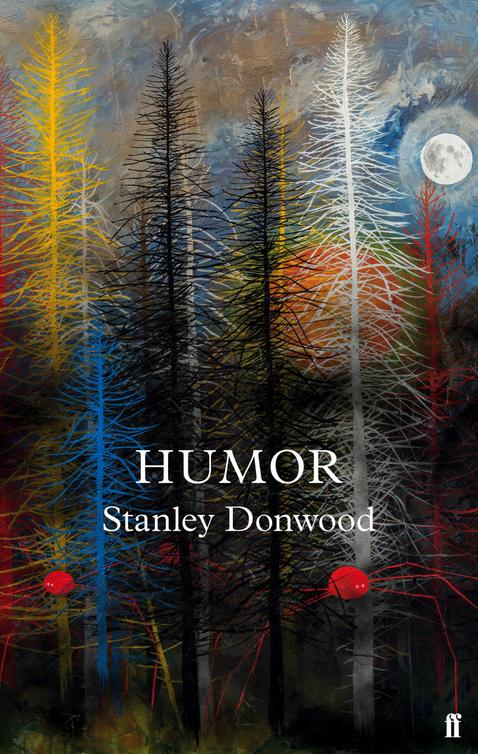Humor
Authors: Stanley Donwood



Stanley Donwood

To
M + I + K
- Title Page
- Dedication
- Introduction
-
- Sanguine
-
- Happiness: A Guide
- Scent
- My Week
- Sky Sports
- Fingers
- Dracula
- Head and Shoulders
- Nearly Got
- Bond James Bond
- New Job
- Loyalty Card
- Airborne
- Futile Gesture
- Chip Shop
- Haunted
- Statue
- Seaside Town of Vampires
- Laboratory
- Big Bird
- Machete
- Burning Pub
- Rubbish Time Machine
- A Wet Night
- Love Story
- On Sundays Ring-Road Supermarket
- Aztec Procession
- Acting with Certainty
- Trouble with Neighbours
- Game
- A Quiet Afternoon
- Shears
-
- Phlegm
-
- Wage Packet
- Sell Your House and Buy Gold
- My Giro
- Here Be Dragons
- Peace and Quiet
- Condiment
- Straw
-
- Choler
-
- For Modern Living
- None of the Above
- Only a Nightmare
- Daydream
- Some Nuclear Reactors
- A Green Park for Business
- Except
- Perspective
- Sweaters
- Murder
- East Croydon
- Inflatable Black-Rubber Stately Home
- Midsummer’s Day in a Graveyard
- Camera
- Attraction
-
- Melancholy
-
- Very Cold
- Telescope
- Quiet Beckoning
- Romance
- Island of Doctor Moreau
- Space
- Faded Notice
- Lachrymose
- Designer-Outlet Village
- Rural Idyll
- Beautiful Story About
- Snuff
-
- About the Author
- By the Same Author
- Copyright
It happened every year. The first year it was not too bad; just a scream that died in my throat upon waking. The details of the dream were already cloudy in my mind; all I knew for certain was that it had been very, very bad. This was when I still had nightmares. I had a lot of nightmares, but this one was particularly unpleasant.
Everyone has bad dreams; some more than others, some dreams worse than usual. What bothered me was that each year I had the same nightmare, but each time the dream contained the next part, the next … chapter. The events of this dream refreshed my memory of the previous one, and there was no doubt about it: it was a continuation. I became a little worried and I sought out books about dreams to salve my thoughts. I hadn’t paid much attention to books about dreams, but now I found out that there were many. A number of them dealt with the interpretation of dreams, but I wasn’t very convinced by them. I didn’t think that my dreams needed interpretation; they just needed stopping.
I read Freud on dreams and Jung on dreams; I read R. D. Laing and I read a very odd and disturbing book called
Lucid Dreams
by Celia Green.
*
Lucid dreams are
dreams in which you know you are dreaming. This alarmed me, as it indicated a fraying of the fabric between wakefulness and dreaming, and the dreams I was having were starting to suggest to me that any sort of fraying of this kind would be extremely dangerous. There were demons in my dreams and I had absolutely no desire to let them out.
I was perhaps a little crazy. I thought that the nightmares were real, that what happened in them was as important as, or equal to, what happened to me during the day. The fear of the next chapter of one dream in particular – the one that was, I realised, due any time now – bothered me a great deal.
And naturally it came. It was indescribably terrifying, a horrific, ghastly, full-colour epic featuring baskets full of severed heads, interminable periods of supermarket shopping, an electrifyingly fearsome man who continued to live and speak after I had smashed his brains out in a fireplace, and extremely beautiful rural scenery.
I woke up, wrenched out of the nightmare as if dropped from a helicopter, pouring with cold sweat, wild-eyed and panicking. I knew now that the ‘man’ I had killed (but not killed) was a demon, or a devil, and that he/it was a particular demon; he was my demon. I felt hopelessly awful; this had, indeed, been the next part of the particular dream I had feared the most, and it was definitely getting ‘worse’.
I wasn’t even sure if it had been a year since the previous chapter … Surely it hadn’t been? The details of the dream, now, showed no signs of clouding, no amelioration by the daylight. The dream was at least as real as the attic
room I slept in, probably more real. It had certainly been convincing. As far as I knew all earthly laws of physics had been adhered to within the dream; perspective worked normally, birds sang in trees, rabbits scurried away at my approach. Even the details were right: the top bar of a gate had been worn by use, patinated with human touch; species of tree were clearly identifiable; the baskets full of severed heads were real baskets, woven from willow, smeared with blood. Dreams were not supposed to contain supermarkets, certainly not supermarkets with special offers and litter blowing in the breeze outside. The only thing that had not been real was that fucking demon.
I was absolutely terrified. The border where waking life met dreaming life seemed to be in the process of fracturing, and if that happened there was no predicting what might happen next. I couldn’t sleep. That was completely out of the question, utterly unthinkable, if I were going to stay normal and not get any crazier than I already felt. Staying awake, however, brought with it several consequences.
One of these consequences, with horrible irony, was that my ability to determine whether I was asleep or awake became compromised. It got harder to know which was which, because fighting sleep is exhausting, and an exhausted body craves sleep intensely, no matter what the brain attached to that body may wish for. The body and mind become disassociated, and I became clumsy, forgetful and vague. This was not working.
Sleep returned to my life and with it came a blizzard of nightmares, but these were merely awful tremors. I lived in fear of ‘the big one’. What I was most concerned about was
the fact that ‘the big one’ carried harbingers of my death: not my death in life, but my death in the nightmare. That demon wanted me with a coldly implacable desire, and when he got me I would die in that nightmare and that’s where I would stay, in some unspeakably nasty eternity, everything repeating itself, round and round, unbearably. I knew that there were only a finite number of chapters in that nightmare, and with each chapter the end came irrevocably closer. The end of the dream was the end of me.
I began to take steps to protect myself. My housemates found me chalking the letters LIVED on the soot in our fireplace, as I was convinced that the hearth was a possible entry point for the demon. Somewhere I had read that this was an effective strategy, the theory being that if the demon sees the word DEVIL written backwards he will return to where he came from, tricked into thinking that he’s in a mirror-world.
I also began to write my nightmares down. This started as a way to keep track of them, to make absolutely sure of the sequential nightmare, to record and identify any possible channels of resistance. Themes began to emerge: supermarkets, the early hours of the morning (just before sunrise), medieval and Tudor architecture, aliens, demons (obviously), transmogrification, hauntings, enormous evergreen hedges and landscapes that were eerily reminiscent of golf courses, with trees spaced at equal intervals and closely-mown grass.
I edited the written versions ruthlessly, cutting out swathes of text. There was no sense in trying to contextualise these night-time journeys, no point in attempting to
fit them with a beginning or an end. As far as I could tell these frightening excursions were all middle. I wrote in the first person, naturally, and in the present tense.
I decided to dilute my dreams by sending these written versions to a disparate group that I had been corresponding with for several years, in a kind of one-way mail-art. If enough people read the dreams they would dissipate, their power dispersed into the ether like some sort of noxious vapour. I made small booklets and placed them in envelopes, posting them with a sense of slight relief. This was a cathartic offloading of internalised menace that I hoped would help calm the night. I called these booklets
Small Thoughts
.
At this time I had been working with Radiohead on the record that was to become
OK Computer
, in a large mansion house not too far from where I lived. I came across a book about the art of Jean-Michel Basquiat, and I ordered the book of symbols
†
that he had used as a reference while making such paintings as
Untitled
(
Pecho/Oreja
) and
Untitled
(
Per Capita
).
The symbols were a revelation. As well as many that found their partially erased way into the artwork for
OK Computer
, there was exactly the mark I was looking for. It was a hex, a magic symbol that would bring bad luck and misfortune to demons. Hexes are normally very bad;
certainly not the sort of thing you’d like to find scratched onto your front door. This one, however, was extremely useful. I started using it immediately, chalking it on walls (and also, of course, on the soot of our fireplace) and reproducing it in various pieces of artwork, some of them used in the
OK Computer
artwork, others on t-shirts and posters. The more places where the symbol was inscribed the better; I was very pleased to engineer the pasting of Barcelona’s streets with enormous posters bearing not only the symbol – large, black on white – but also, unmistakeably, the words AGAINST DEMONS.
Meanwhile I was writing more and more of the nightmares down, pinning them to the page like speaking moths. The internet was another canvas on which to pour these expulsions, and at the same time as building the first version of
radiohead.com
I started compiling
slowlydownward.com
. This eventually led to the first publication of the written dreams in book form, as the first edition of
Slowly Downward
was published a few years later, using texts the publisher Ambrose Blimfield took directly from the website.
Over the course of a few years the dreams were read by many people, either from the booklets, from a circular tin of dreams, from a bag of dreams, from the website, from the Radiohead artwork I inserted them into, or from the book. The ‘Against Demons’ symbol had travelled all over the world, thanks to Radiohead’s punishing tour schedules, and I had seen photographs of it turned into a tattoo.
It is impossible for actions not to have a consequence, and so it was that my nightmares ceased utterly. In one
dream I learned the name of my tormentor, which helped a lot, but overall I believe it was the concerted attack that stopped it all. The chapters never advanced any further, and eventually even the mild nightmares passed.
However I do slightly regret their disappearance, as now, of course, I have nothing to write about. Although I remember enough to be extremely careful what I wish for.
Stanley Donwood, 2014
*
Published by the Institute of Psychophysical Research, Oxford, 1968.
†
Symbol Sourcebook: An Authoritative Guide to International Graphic Symbols,
by Henry Dreyfuss, published by McGraw-Hill (1967). This is the book in which I first came across the medical notation sign meaning ‘NO DATA’, which I consequently used as the title for two separate exhibitions.
